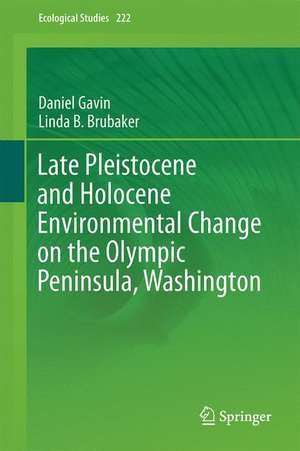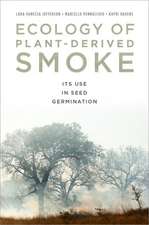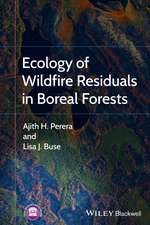Late Pleistocene and Holocene Environmental Change on the Olympic Peninsula, Washington: Ecological Studies, cartea 222
Autor Daniel G. Gavin, Linda B. Brubakeren Limba Engleză Hardback – 8 dec 2014
| Toate formatele și edițiile | Preț | Express |
|---|---|---|
| Paperback (1) | 633.53 lei 6-8 săpt. | |
| Springer International Publishing – 10 sep 2016 | 633.53 lei 6-8 săpt. | |
| Hardback (1) | 639.73 lei 6-8 săpt. | |
| Springer International Publishing – 8 dec 2014 | 639.73 lei 6-8 săpt. |
Din seria Ecological Studies
- 18%
 Preț: 1118.93 lei
Preț: 1118.93 lei -
 Preț: 553.72 lei
Preț: 553.72 lei - 18%
 Preț: 1680.55 lei
Preț: 1680.55 lei - 18%
 Preț: 1003.38 lei
Preț: 1003.38 lei - 20%
 Preț: 1004.71 lei
Preț: 1004.71 lei -
 Preț: 480.62 lei
Preț: 480.62 lei - 5%
 Preț: 752.26 lei
Preț: 752.26 lei - 15%
 Preț: 643.99 lei
Preț: 643.99 lei - 15%
 Preț: 644.18 lei
Preț: 644.18 lei - 15%
 Preț: 652.49 lei
Preț: 652.49 lei - 18%
 Preț: 789.83 lei
Preț: 789.83 lei -
 Preț: 382.36 lei
Preț: 382.36 lei - 15%
 Preț: 643.48 lei
Preț: 643.48 lei - 15%
 Preț: 646.30 lei
Preț: 646.30 lei - 15%
 Preț: 634.32 lei
Preț: 634.32 lei -
 Preț: 384.86 lei
Preț: 384.86 lei - 18%
 Preț: 789.98 lei
Preț: 789.98 lei - 15%
 Preț: 645.14 lei
Preț: 645.14 lei - 15%
 Preț: 649.39 lei
Preț: 649.39 lei - 18%
 Preț: 1005.43 lei
Preț: 1005.43 lei - 18%
 Preț: 949.23 lei
Preț: 949.23 lei - 15%
 Preț: 649.54 lei
Preț: 649.54 lei - 15%
 Preț: 643.34 lei
Preț: 643.34 lei - 15%
 Preț: 649.71 lei
Preț: 649.71 lei - 15%
 Preț: 638.76 lei
Preț: 638.76 lei - 18%
 Preț: 957.62 lei
Preț: 957.62 lei - 18%
 Preț: 1235.25 lei
Preț: 1235.25 lei - 18%
 Preț: 962.18 lei
Preț: 962.18 lei - 18%
 Preț: 949.23 lei
Preț: 949.23 lei - 15%
 Preț: 660.68 lei
Preț: 660.68 lei -
 Preț: 397.76 lei
Preț: 397.76 lei - 15%
 Preț: 638.24 lei
Preț: 638.24 lei - 18%
 Preț: 942.31 lei
Preț: 942.31 lei - 18%
 Preț: 1232.57 lei
Preț: 1232.57 lei - 15%
 Preț: 651.34 lei
Preț: 651.34 lei - 18%
 Preț: 952.72 lei
Preț: 952.72 lei - 18%
 Preț: 1834.27 lei
Preț: 1834.27 lei - 18%
 Preț: 1229.10 lei
Preț: 1229.10 lei -
 Preț: 423.95 lei
Preț: 423.95 lei - 18%
 Preț: 948.92 lei
Preț: 948.92 lei
Preț: 639.73 lei
Preț vechi: 752.63 lei
-15% Nou
Puncte Express: 960
Preț estimativ în valută:
122.43€ • 132.94$ • 102.84£
122.43€ • 132.94$ • 102.84£
Carte tipărită la comandă
Livrare economică 23 aprilie-07 mai
Preluare comenzi: 021 569.72.76
Specificații
ISBN-13: 9783319110134
ISBN-10: 3319110136
Pagini: 142
Ilustrații: XII, 142 p. 52 illus., 36 illus. in color.
Dimensiuni: 155 x 235 x 14 mm
Greutate: 0.4 kg
Ediția:2015
Editura: Springer International Publishing
Colecția Springer
Seria Ecological Studies
Locul publicării:Cham, Switzerland
ISBN-10: 3319110136
Pagini: 142
Ilustrații: XII, 142 p. 52 illus., 36 illus. in color.
Dimensiuni: 155 x 235 x 14 mm
Greutate: 0.4 kg
Ediția:2015
Editura: Springer International Publishing
Colecția Springer
Seria Ecological Studies
Locul publicării:Cham, Switzerland
Public țintă
ResearchCuprins
1. The modern landscape of the Olympic Peninsula.- 2. Geology and historical biogeography of the Olympic Peninsula.- 3. Postglacial climate on the Olympic Peninsula.- 4. Late Quaternary vegetation and fire history of the Olympic Peninsula.- 5. Brief review of the archeological record in a context of environmental change.- 6. Insights and future research needs.
Textul de pe ultima copertă
Utilizing a paleoecological approach, this volume brings together decades of research on the modern natural environment of Washington State’s Olympic Peninsula. This review of past research on paleoenvironmental change since the Late Pleistocene presents paleoecological records of changing forest composition and fire over the last 14,000 years. This volume, and its conclusions, draws extensively from Dr. Daniel Gavin and Dr. Linda Brubaker’s study of five Olympic Peninsula pollen records.
The Olympic Peninsula is an ideal setting for studying the responses of ecosystems to past climate change. Located just south of the maximum ice-sheet extent during the Last Glacial Maximum, there is abundant evidence that it functioned as a glacial refugium; 29 taxa endemic to the peninsula likely persisted in such refugia. Furthermore, its uniquely steep rainfall gradient produces a wide range of habitats over short distances. A literature review, synthesis of published data, and close examination of the authors’ investigations of post-glacial climate and vegetation change, this book features detailed color maps and data graphics.
The Olympic Peninsula is an ideal setting for studying the responses of ecosystems to past climate change. Located just south of the maximum ice-sheet extent during the Last Glacial Maximum, there is abundant evidence that it functioned as a glacial refugium; 29 taxa endemic to the peninsula likely persisted in such refugia. Furthermore, its uniquely steep rainfall gradient produces a wide range of habitats over short distances. A literature review, synthesis of published data, and close examination of the authors’ investigations of post-glacial climate and vegetation change, this book features detailed color maps and data graphics.
Caracteristici
Offers reviews of past studies of the Olympic Peninsula as well as new data and analysis from the authors Updated presentation and analysis of studies from the 1950s through 1980s offers a historical baseline and exposes readers to previously inaccessible data The records presented show how climate change of the late Pleistocene and Holocene periods affected the biodiversity of the Olympic Peninsula This data sheds light on the potential impacts of projected climate change Includes supplementary material: sn.pub/extras











